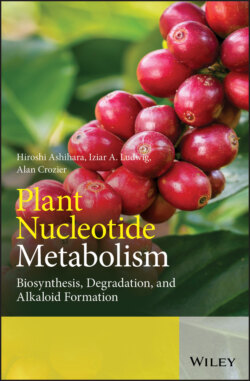Читать книгу Plant Nucleotide Metabolism - Hiroshi Ashihara - Страница 54
4.2.1 Synthesis of Phosphoribosylamine
ОглавлениеPurine biosynthesis de novo starts with the formation of phosphoribosylamine (PRA) from PRPP and glutamine (step 1, Figure 4.1, Reaction 1).
This reaction is catalysed by 5-phosphoribosyl-1-pyrophosphate amidotransferase (PRAT, EC 2.4.2.14). PRAT has been purified from a number of sources, including E. coli, and Bacillus subtilus, avian liver, and human placenta. In plants, a highly purified native enzyme has been obtained from root nodules of soybean (Glycine max) (Reynolds et al. 1984). In tropical legumes, ammonia, a direct product of symbiotic nitrogen fixation in roots, is converted to ureides (allantoin and allantoic acid) which are translocated to the shoot where they serve as a nitrogen source. Ureides are generated through the oxidation of purines formed by the de novo purine biosynthetic pathway. PRAT catalyses the first committed step of ureide biosynthesis in soybean. Nodule PRAT has a pH optimum of 8.0, and Km values of 18 mM for glutamine and 0.4 mM for PRPP. Ammonia can replace glutamine as a substrate (Km ∼14 mM) and the Vmax with ammonia is double that obtained when glutamine is the substrate. Regulatory properties of the soybean root nodule enzyme are similar to those reported for the human placental enzyme (Holmes et al. 1973). Both are subject to regulation by end products of the purine biosynthetic pathway, IMP, xanthosine-5′-monophosphate (XMP), guanosine-5′-monophosphate (GMP), and adenosine-5′-monophosphate (AMP). Therefore, the first step of purine biosynthesis de novo is feedback controlled by the end products in both plants and animals.
In plants, there are three isoforms of PRAT (AtPRAT1–3) which are coded in a family of three isoforms of pur1. In A. thaliana, AtPRAT2 is the major isoform (Hung et al. 2004). One of the pur1 genes which encodes AtPRAT1 protein is expressed in roots and flowers. The AtPRAT2-encoding gene is expressed in leaves as well as roots and flowers (Ito et al. 1994), while the gene that encodes AtPRAT3 is expressed at very low levels in silique, cauline leaves, and roots (Hung et al. 2004).
Figure 4.1 Purine ribonucleotide biosynthesis. Abbreviations of metabolites are as follows: PRPP, 5-phosphoribosyl-1-pyrophosphate; PRA, 5-phosphoribosyl amine; GAR, glycineamide ribonucleotide; FGAR, formylglycineamide ribonucleotide; FGAM, formylglycinamidine ribonucleotide; AIR, 5-aminoimidazole ribonucleotide; CAIR, 5-aminoimidazole 4-carboxylate ribonucleotide; SAICAR, 5-aminoimidazole-4-N-succinocarboxyamide ribonucleotide; AICAR, 5-aminoimidazole-4-carboxyamide ribonucleotide; FAICAR, 5-formamidoimidazole-4-carboxyamide ribonucleotide; SAMP, adenylosuccinate; XMP, xanthosine-5′-monophosphate; IMP, inosine-5′-monophosphate; GMP, guanosine-5′-monophosphate; AMP, adenosine-5′-monophosphate; Asp, aspartate; Gln, glutamine; Gly, glycine; 10-THF, 10-formyltetrahydrofolate. The participated enzymes are (1) PRPP amidotransferase (2.4.2.14); (2) GAR synthetase (6.3.4.13); (3) GAR formyl transferase (2.1.2.2); (4) FGAM synthetase (6.3.5.3); (5) AIR synthetase (6.3.3.1); (6) AIR carboxylase (4.1.1.21); (7) SAICAR synthetase (6.3.2.6); (8) adenylosuccinate lyase (4.3.2.2); (9) AICAR formyl transferase (2.1.2.3); (10) IMP cyclohydrolase (3.5.4.10); (11) SAMP synthetase (6.3.4.4); (12) adenylosuccinate lyase (4.3.2.2), the same enzyme for step 8; (13) IMP dehydrogenase (1.1.1.205); (14) GMP synthetase (6.3.5.2).
The nitrogen-fixing root nodules of Phaseolus vulgaris (common bean) also have three pur1 genes coding for PRAT (Coleto et al. 2016). One of the three pur1 genes which encodes PvPRAT3, is highly expressed in nodules and the enzymatic activity is correlated with nitrogen fixation activity. Some mutant studies suggest that PvPRAT3 is essential for the synthesis of ureides in nodules.
The formation of PRA from PRPP and glutamine occurs as two consecutive reactions that take place at separate active sites on PRAT.
1 (i) glutamine + H2O → glutamate + NH3
2 (ii) NH3 + PRPP → PRA + PPi
Ammonia is released at the glutaminase domain and channelled to the PRPP binding site in the phosphoribosyltransferase domain (Zalkin and Dixon 1992). PRAT is structurally classified into two groups, namely, [4Fe-4S] cluster-dependent (type I) and independent-enzyme groups (type II). Plant PRAT displays the typical conserved protein structures of type I, containing a propeptide preceding the first cysteine and four conserved cysteine residues that are ligands to a [4Fe-4S] cluster and crucial for catalytic activity and feedback regulation (Ito et al. 1994).
